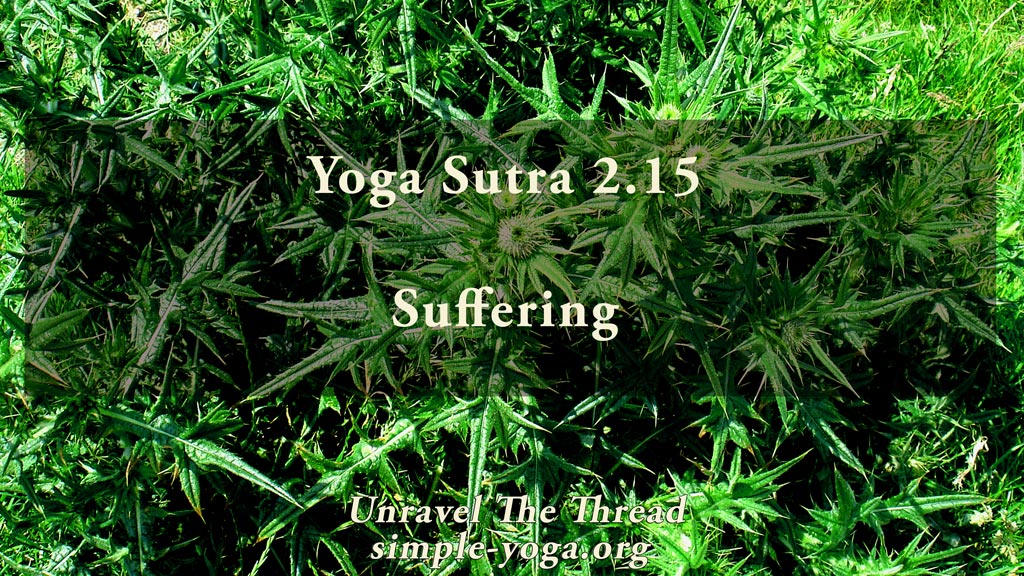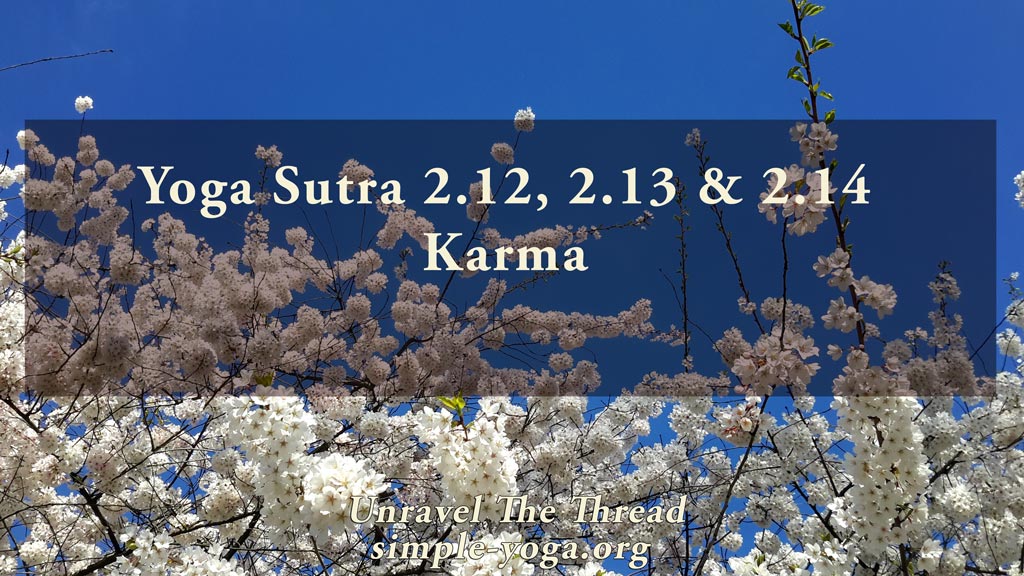
2.11 Meditation counteracts active afflictions
May 16, 2020
2.15 Suffering
June 1, 2020
2.11 Meditation counteracts active afflictions
May 16, 2020
2.15 Suffering
June 1, 20202.12 2.13 & 2.14 Karma

KARMA
2.12 These afflictions (kleshas) are the source of an accumulation of impressions (samskaras) that influence present and future experiences (karma).
2.13 Determining birth, lifespan and quality of life experiences.
2.14 Producing pleasant and unpleasant experiences according to virtues and defects.
These three verses explain the concept of karma. Karma in Sanskrit means action. Every action creates an echo that ripples out through the interconnectedness of all that exists. Additionally, every thought, every intention and every action generate an impression (samskara) in you. The emotions that emerge as a result act as stimuli that strengthen your cravings, your resistance, your self-importance and your sense of who you are. These impressions are stored consciously and unconsciously in the core of your being. Patañjali refers to this body of impressions as the store of karma (karmashaya). Each impression becomes a seed, influencing your future thoughts, intentions and actions. For instance, when you are upset and have something to eat, it is likely that what you taste may be unconsciously associated with your mood; and possibly, in the future, every time that you eat the same thing, it will influence your mood, or the taste may remind you of that occasion when you were upset. Verse 2.13 says that these afflictions (kleshas) and related impressions (samskaras) influence not only your current life but also the conditions of future embodiments. According to the originating actions, the resulting experiences will be pleasant or unpleasant (2.14). Consequently, the seeds of new impressions will be planted, perpetuating an ongoing cycle that ends up determining how your life progresses. As you consider this process, it is important to remember that when you are distracted from the present moment, by either thinking about the past or trying to predict the future, you may not even be aware of what you are doing. As a result, in addition to cultivating a tendency towards distractedness, you may be completely oblivious to some of the seeds you are planting, and you may be surprised by the effects of previous actions you were not even cognizant of.
You can gain insight into this process as you observe your life choices. For instance, recalling specific moments in your past, you can see some of the choices and decisions that influenced your identity, perspective and circumstances. You can also notice how all those elements combined to create likes, dislikes, restrictions and opportunities. As you contemplate the various stages of your life, aided by the perspective of time, you can see what you have made important. Staying out of the tendency to take personally what is currently happening in your life can enable you to witness the seeds that you are planting and how they will generate similar thoughts and actions in the future. As you reflect on your life, contemplate the fact that anything that you do regularly will add to your ways of being, perceiving and interpreting the world. If you spend a whole day saying, “I hate this, I hate that, I hate….,” your own internal environment will feel quite different from when you spend your whole day saying, “I am at peace with this, I am at peace with that, I am at peace with….” As a simple experiment, you may even try these two options, each one for only a few minutes, to notice the effect of each on your attitude, outlook and internal environment. Some other useful questions to live with include: What motivates this intention? What are my expectations for this action? To what extent am I creating a new craving or new source of resistance? Does this action increase my sense of self-importance? How is this thought contributing to clarify who I am? How are my current circumstances related to some of my past actions? How am I contributing to enhance the quality of life where I am?
As usual, one more way of exploring the meaning of this sutra is by chanting it.
You can choose to chant it in its traditional form with some of the words coming together:
For sutra 2.12
2.12 kleśamūlaḥ karmāśayo dṛṣṭādṛṣṭajanmavedanīyaḥ
क्लेशमूलः कर्माशयो दृष्टादृष्टजन्मवेदनीयः ॥१२॥
Another option is to chant each word in the sutra individually:
- kleśa
- mūlaḥ
- karma
- āśayaḥ
- dṛṣṭa
- adṛṣṭa
- janma
- vedanīyaḥ
For sutra 2.13
2.13 sati mūle tadvipāko jātyāyurbhogāḥ
सति मूले तद्विपाको जात्यायुर्भोगाः ॥१३॥
Another option is to chant each word in the sutra individually:
- sati
- mule
- tat
- vipākaḥ
- jāti
- āyuḥ
- bhogāḥ
For sutra 2.14
2.14 te hlāda paritāpaphalāḥ puṇyāpuṇyahetutvāt
ते ह्लाद परितापफलाः पुण्यापुण्यहेतुत्वात् ॥१४॥
Another option is to chant each word in the sutra individually:
- te
- hlāda
- paritāpa
- phalāḥ
- puṇya
- apuṇya
- hetutvāt
If you prefer, you may listen to the podcast:
Unravel the thread is now available as a book!
If you find Simple-Yoga.org and Unravel the thread useful, consider supporting my labor with a donation, you may also donate using PayPal or Venmo. Thank you!
